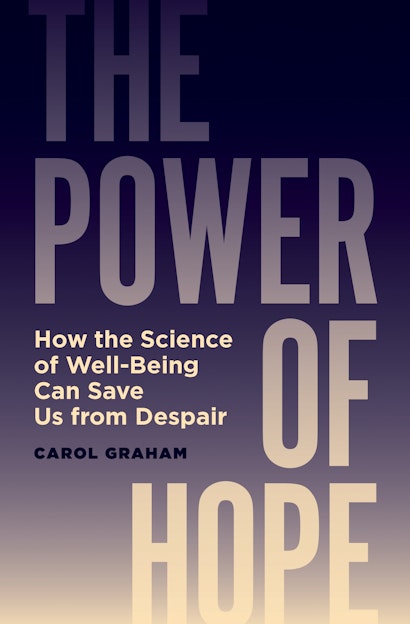I have spent much of my career as an economist studying the determinants of happiness in people in different countries and cultures around the world and, in turn, exploring how happiness affects important life outcomes such as work, health, longevity, and social life. While at first wellbeing was not considered the domain of economists, it is now a subfield in economics and includes collaboration with scholars in other disciplines, such as psychology, psychiatry, and the biological sciences as well.
Over time, I have found increasing evidence that the most important dimension of wellbeing to future outcomes is not happiness, although of course it matters, but hope. Hope is distinct from optimism, which is the belief that things will get better, as it is based on individuals believing that they can make things better, and reflects agency. In contrast, people without hope tend to have miserable life outcomes.
The U.S. is experiencing a nationwide crisis of despair. Mental health problems are on the rise and deaths from self-inflicted causes such as suicide and drug overdose—deaths of despair as defined by Anne Case and Angus Deaton—(Rising morbidity and mortality in midlife among white non-Hispanic Americans in the 21st century | PNAS) are at unprecedented levels, with over 100,000 U.S. deaths from overdoses in 2021 alone. Despair is not only linked with premature mortality, but with the vulnerability to misinformation that is plaguing our society, our health systems, and our democracy. Individuals in despair—defined as having no hope and being ambivalent about life versus death—are prone to believe fake news and related conspiracy theories.
Sadly, the young, who seem to have suffered disproportionately from the uncertainty and distress that COVID and many other trends, such as unpredictable labor markets and rising inequality, are also newly represented in these deaths in the past few years. A recent CDC study, for example, found a major rise in sadness and vulnerability to suicide, with 57% of girls reporting sadness in the previous two weeks, a four-fold increase since 2011. My Brookings Institution research, as well as that of many others, has found a steady increase in depression and anxiety among the young, also beginning in 2011. Suicides increased significantly among younger minorities in 2021, meanwhile, after a two-year decline, while they continued to decline (from higher rates) among whites and older people.
Psychiatrists often note that restoring hope is a first step to recovering from mental illness, but there is no guidepost for doing so. Hope, while in the title of many books and in countless poems and conversations, is an understudied concept in the social sciences. In my new book, The Power of Hope: How the Science of Well-Being Can Save Us from Despair (Princeton University Press, 2023), I explore what we know and do not know about hope and how it can be used to help solve this crisis.
Hope, like IQ, has genetic properties but is also influenced by the environment that people live in. Like many personality traits, hope is malleable much later in life than is IQ, which does not change much after the twenties, providing us with opportunities to increase it but not with lessons for doing so. There are, however, some examples from wellbeing science that can serve as a starting point.
Hope also has racial and cultural determinants and can be influenced by the community in which people live. In surveys of low-income adolescents in Lima, Peru and St. Louis, Missouri, I found the same differences in hope that we see across cultures and races more generally. The least optimistic adolescents are low-income whites, who have no aspirations for education beyond high school. In contrast, even though more materially deprived, low-income Black adolescents are much more likely to trust others and to aspire to some form of higher education. In addition, they tend to have a mentor or family member who supports those aspirations, in contrast to the white youth. The Peruvian adolescents, like the minorities in Missouri, tend to have very high education aspirations and report support from their families or communities.
If these trends remain unaddressed, we are likely to see another generation in despair. Young adults entering the labor market face new and unknown challenges. While college education is expensive and not always the solution, the labor force of the future will increasingly require socio-emotional and cognitive skills that are not usually acquired in high school. New forms of education must be part of the solution, as is facilitating the ability of more young adults to attend college. Community colleges, for example, tend to be a good start and at the same time are an important factor as declining communities try to build back and attract new forms of economic activity.
Lack of access to higher education is also linked to vulnerability to misinformation, along with despair. In new research in which we explore the links between despair and misinformation, we are finding that not only are education opportunities critical to economic success and social mobility, but they also play an important role in individuals’ ability to navigate misinformation. Education helps individuals interpret different forms of information and utilize a range of information channels, and involvement in institutions of higher learning also provides a community that supports sharing of information and knowledge. Those in despair and isolation—who often do not have post-high school education—have fewer tools with which to combat misinformation and are much more susceptible to attempts at radicalization.
Communities in general can also play a critical role in the process of reducing despair and restoring hope. Increasingly, community members are playing a role in identifying the vulnerable and assisting in getting them to seek out mental health and other forms of treatment. This is particularly critical in areas which are underserved in terms of health care and mental health care, due to their remote nature (as in rural areas) or to deprived conditions (in urban and rural areas). There are experiences about community wellbeing we can learn from, such as from the U.K.’s What Works Wellbeing Centre and the Virtual Hands Collaborative in the U.S., among others.
Equally critical is supporting the hopes and aspirations of the next generations so that they pursue opportunities when they are available. Hope’s agentic qualities play a critical role as individuals make decisions about their futures. Economists and other social scientists have only begun to recognize the importance of feelings in decision-making, but there is abundant evidence in both experiments and in practical experience. While we do not know much about restoring hope, it will be key to the success of the next generation—as are mentors that can support their hopes and aspirations. Our research finds that having a mentor who supports the hopes and aspirations of the young is a critical factor in their decisions to invest in their futures, such as in education, and to avoid risky behaviors which jeopardize those futures.
These are uncertain times. Given the damage that despair has already caused, including the prematurely lost lives of well over 100,000 Americans in 2021 alone, its spread to the next generation is a daunting thought. It is urgent that we expand our knowledge and put what we do know into practical policies. The science of wellbeing provides us with new tools to do so. Critical moments require radical new thinking on the importance of restoring hope.
Carol Graham is the interim vice president and director of economic studies at the Brookings Institution and College Park Professor at the University of Maryland. She is the author of Happiness around the World: The Paradox of Happy Peasants and Miserable Millionaires; The Pursuit of Happiness: An Economy of Well-Being; Happiness for All? Unequal Hopes and Lives in Pursuit of the American Dream (Princeton); and other books, as well as numerous articles in academic journals.

